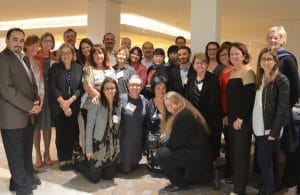 IFAAA meeting attendees from 19 countries.
IFAAA meeting attendees from 19 countries. In a single day, physicians, scientists, advocacy organizations and patient representatives presented a program that covered the emerging understanding of food allergy as a disease, the vital need to ratchet up research efforts and find more therapy approaches, emerging allergens, travel accommodations, the psychological issues of living with food allergies – and even whether related cognitive behavioral therapy (or CBT) could be approached in an online format.
As a parent in the food allergy community, it was hugely encouraging to witness the medical and science professionals listening intently to those presenting patient insights into the realities of life with food allergies. Patient quality of life issues (from school, to travel and social life) were also discussed in lively Q&A periods. I believe that including the patient perspective in this type of forum will help to shape the global food allergy agenda in a meaningful way.
Highlights from the 2017 IFAAA meeting:
- Mary Jane Marchisotto, FARE’s senior vice president of research and international, spoke on the pressing need to improve both the quality of care and quality of life for food allergy patients. She told the audience that FARE has now invested more than $6.5 million in the recently expanded FARE Clinical Network. This collaborative network, which is now composed of 29 centers of excellence, is working to facilitate and accelerate the development of therapies for patients with food allergies. At the same time, it aims to improve diagnosis and reduce discrepancies in patient care.
- In a presentation titled “The Good, The Bad and the Ugly,” Dr. James Baker, FARE’s CEO and chief medical officer, explained the therapeutic interventions currently available, what is coming down the pike and what still needs to be done. “We have a moral requirement toward people with food-allergic disease,” he said. “They deserve an honest appraisal of what research means and what they can expect long term.”
 Dr. James Baker, FARE's CEO and chief medical officer
Dr. James Baker, FARE's CEO and chief medical officer Baker spoke of the new FARE Patient Registry and why it is so vital, underscoring that one of the biggest roadblocks to understanding food allergy is a lack of accurate, large-scale information about individuals with the disease. The data the registry collects will allow for the discovery of subgroups of patients with identifiable allergy causes, unique environmental exposures or who are likely to respond to a certain type of therapy.
Baker also told the IFAAA meeting of FARE’s investigator awards, designed to encourage and attract bright young and mid-career investigators in the field, and broaden clinical findings. I’m told the organization has invested $3.5 million to date in this program.
-
Also speaking was one of those mid-career award award recipients – Erik Wambre, PhD, of Seattle’s Benaroya Institute. Wambre is the author of a recent study that identified a key group of cells – dubbed Th2A cells – that are only present in people with allergies. The research, which took seven years, is highly significant, as it could impact how allergies are identified and treated.
Erik Wambre, PhD
To help the non-scientists at this meeting, Wambre drew a brilliant analogy to the Star Wars movies to help explain his research. He said to think of IgE antibodies involved in the allergic response as representing Imperial forces troopers. Even though the troopers are destroyed in each of the Star Wars films, they come back – as evidenced with the release of the next episode. Why? The main reason is that there is still a Dark Force out there. Wambre describes his research as focusing on fighting the force, not the (IgE) soldiers. This gave an intriguing sense of how allergy researchers have to stay mindful of the bigger picture with this multifactorial disease.
- Speaking on the psychological impact of food allergy was Rebecca Knibb, a psychologist at Birmingham’s Aston University. She stressed that eating is a key part of life, and noted the incidence of anxiety and depression in food allergy population. Knibb said worry and stress about coping vary with age. In her research, young children with food allergies did not find food allergy had much impact on life. However, older children reported food allergies making them “feel different,” and restricting their social life. Interventions such as group support, online support and cognitive behavioral therapy (CBT) can improve life for the food-allergic patient and family. In the group’s discussion, one of the other panel members spoke of her son completing oral immunotherapy for his peanut allergy, and she credited CBT sessions for turning the experience around from negative to positive. The discussion turned quite forward-thinking and promising: with ideas put forward for collaborating and developing an online CBT resource for patients.
 Teddy Kider
Teddy Kider - Teddy Kider, a 32-year-old attorney, had a huge impact on the audience as he spoke about the quality of his life as a dairy-allergic adult. He reminded the audience that food allergy is not just about kids being cared for by parents and schools, but also about adults like him, living out in the world. He spoke about how recognizing food allergy as a disability affects every part of his life. Teddy shared that he has suffered anaphylaxis many times and visited emergency rooms around the globe. He spoke eloquently about the ever-present issue of his dairy allergy when he navigates work events, travels for business and pleasure, and when attending events such as a recent wedding of a friend, where nothing was safe for him to eat.
Kider is a member of FARE’s Outcomes Research Advisory Board, which was formed to bring the patient voice to the prioritization of food allergy research. Several medical professionals remarked how Kider’s presentation gave them pause for thought, comments that patient representatives like me were glad to hear.
The lawyer’s talk also led to one of the liveliest Q&A periods, and illustrated that, while using the term “medical disability” for food allergy may be common in the U.S. for legal rights and access, it’s by no means universal. Clearly different countries perceive the term disability differently, with one Italian representative suggesting the term “disability” may impede access in her country.
- British patient advocate Boaz Gaventa also gave an inspiring presentation, speaking of how he’d learned “to own” his multiple food allergies. He listed so many food allergies that I lost count. Now a third-year medical student, this extraordinary young man stressed that “being an advocate for yourself can help to get the best out of life, and live it fully.” (And, of course, he gave kudos to his mom!)
- Dr. Gideon Lack, co-author of the famous LEAP study, spoke about allergy prevention. He compared missing the opportunity to expose a high-risk infant to peanut before 6 months of age (and likely prevent a peanut allergy) to missing the plane when you arrive too late at the airport. “We need to get in there early,” was the message about such infants without already established peanut allergy.
-
Christina Jones PhD, from Brighton & Sussex Medical School, shared her research that found only 41 percent of young people with food allergies report always carrying their epinephrine and other medications. She stressed the importance of support groups to improve allergy management, yet presented research showing that U.K. health professionals only informed patients about such groups 14 percent of the time. She later spoke to me about food allergy being an “invisible disability,” and the unique challenges this presents since the child or adult “looks well.”
Christina Jones, PhD
- Also from the patient side, as the founder of NoNutTraveler.com, I spoke about the stressful testimonials I’ve collected of flying with food allergies. I related how some U.S. airlines are failing to make any accommodations for allergic passengers, and some are even treating such requests with hostility. Interestingly, Maria Said of Allergy & Anaphylaxis Australia presented on airlines in Australia, all of which carry both adult and junior epinephrine auto-injectors and have airline-specific food allergy action plans in on-board airline manuals, so there is easy access to the plan. In addition, anaphylaxis training for Australian airline crews is conducted by nurses.
From this one international encounter, she has given me encouragement to redouble my efforts with the U.S. airlines industry. The Australian experience gives me a new talking point and I have already reached out to some airlines in an effort to discuss.
Among other topics:
-
Canada’s Dr. Susan Waserman talked about epinephrine access around the globe – and showed the audience the wide variation in the cost of the lifesaving medication.
IFAAA meeting in progress.
- Dr. Magnus Borres, of Thermo Fisher Scientific, gave an eye-opening talk on novel allergens, including a study in Japan that linked wheat in facial soap to 2,000 cases of wheat allergy that have emerged since 2012. He noted that hydrolyzed wheat protein is now banned for use in cosmetics in Japan. Borres also spoke of unusual new cross-reactivity that’s come to light: Would you believe crocodile meat cross-reacting with chicken?
- Sue Barrowcliffe, the general manager for Aimmune Therapeutics in Europe (which is completing clinical research on its OIT product), highlighted the difficulty in getting a drug developed and licensed. Clare Mills, professor of molecular allergology at the University of Manchester, spoke about the wide variation in methods to quantify food allergen thresholds of reactivity. She told the audience how often different kits will yield different results.
- Dr. Anna Nowak-Wegrzyn, allergist and associate professor at New York’s Jaffe Food Allergy Institute at Mount Sinai, talked about testing and interpreting results in the diagnosis of food allergy. She highlighted some of the shortcomings of current food diagnostic tools and the types of testing that are currently in development, which may help physicians diagnosis food allergy more with greater precision.
At this year’s IFAAA meeting, organizations, researchers and individuals were there representing Argentina, Australia, Belgium, Brazil, Canada, Chile, France, Germany, Hong Kong, India, Israel, Italy, Japan, the Netherlands, Qatar, Spain, South Africa, United Kingdom and the United States. Mary Jane Marchisotto lined up the impressive and varied roster of speakers, everyone put their heads together to discuss issues that are common to the allergic community, wherever you live.
But the real beauty of the meeting was the wisdom and insight gleaned from those who live across the globe. Collaborations like this, where one learns from the experiences and best practices of other countries, can only serve to improve quality of life globally for the many millions who live with life-threatening food allergies.
All photos by Yanne Boloh.








